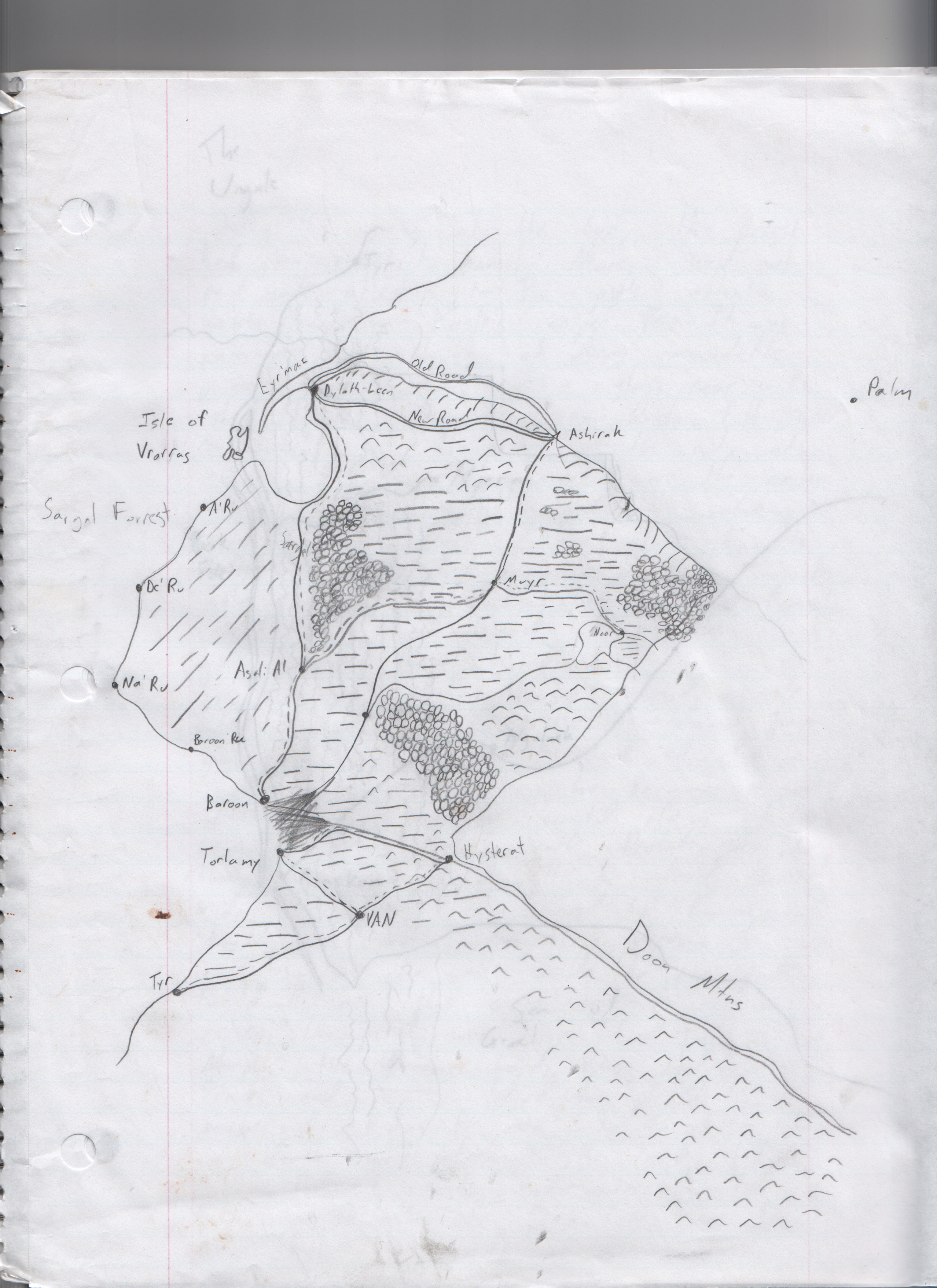
This was in a notebook from at least 2016. The image was scanned July 20, 2017.

For dragon enthusiasts
For work in Pallas

This was in a notebook from at least 2016. The image was scanned July 20, 2017.
The average adult goblin is eight to nine feet tall, 2.4-2.7m, and weighs between one hundred and seventy and three hundred pounds, 77-136kg. There is little to no significant difference in height or weight between males and females. While female goblins do have slightly more developed pelvic areas, this is small compared to individual morphological variance.
In coloring the typical goblin has dark, muted skin without bright pigmentation. Gray, blue, and brown are common, and individuals are rarely monochromatic. Exceptions are often due to albinism or melanism. Skin colors do not vary based on morphological position, except as dictated by exposure, injury, and growth. Like humans goblins tan, and outdoor goblins will frequently have darker coloring on their heads, shoulders, and arms. Blue pigmentation often turns blackish-gray as it darkens, but gray and brown both remain.
Albino goblins are typically killed in infancy. This does not seem to be related to mythological or religious reasons. Goblins exhibiting melanism are often indistinguishable from dark-pigmented goblins save by professional inspection, an infrequent phenomena.
Goblins possess two arms and two legs. Legs and arms are slightly longer than proportional human limbs by ten to twenty percent. Some clans (Throathurters primarily and lineages) have elongated fingers as much as three times human lengths and fifty to one hundred percent longer proportionally. The Throathurter clan combines this with augmented grip strength due to sexual preferences. Grip strength is considered attractive to the point of being a primary sexual differentiator. Other clans usually do not, and suffering from reduced manual leverage have weaker hands than humans. Goblin feet are large and flat. Stonefoots do not have especially hard feet but often have thicker sole-skin.
The goblin head is a large organ. Eyes are deep-set and dark colored with large pupils. Ears are slightly lower than human normal, increased in size, but limp. Goblins are not known for being particularly aural, with typical variance between individuals comparable to humanity. The tusks or fangs are six large teeth similar to human canines. Two primary pairs of teeth, one pair top jaw, one pair bottom, mesh outside the incisors and protrude between the lips. These fangs do not serve predatory purposes typically. Their function is to maintain a parting of the lips to allow breathing. Smaller fangs on the bottom jaw may partially interface outside the upper fangs. The layout is small bottom-jaw fang 1, large upper-jaw fang 2, large bottom-jaw fang 3, incisors top and bottom jaws, large bottom-jaw fang 4, large upper-jaw fang 5, small bottom-jaw fang 6. The ‘clicking’ of the fangs is an inherent part of goblin language. It is sometimes written as a click, and often a part of how goblins pronounce the human sound T.
The goblin nose is located in the center of the roof of the mouth. It has two nostrils, though they meet in the nasal cavity only a quarter inch, <1cm, from the mouth cavity. They are separated by an intrusion of the palate.
Goblins are fully capable of taste but have reduced smell compared to humans. Function is similar, though the morphological constraint of the nostrils being internal should not be underestimated. (The common superstition that goblins smell as well as canines does not seem to be supported at all, and author speculates it is caused by the sound of sniffing created when a goblin attempts to use scent identification. Audible sniffing may imply great capability in this field. Author reiterates this is speculation, but included due to frequent appearance in human culture.)
I updated the Archives page with locations.
Tapas episode 4 can be found at https://tapas.io/series/Bloodharvest
Casual murder wasn’t against Krat. If you saw someone and had a disagreement with them, that was fine. Krat said if you ganged up to kill someone you had to fight sequentially, and if you challenged them and they submitted, you had to accept that. Let’s say just one goblin decided to rob another. If the first ran up behind the second and strangled him, she hadn’t violated Krat. More local rules and laws on robbery and murder reigned. But if the robber demanded money and the other goblin gave it to her, then she couldn’t strangle him in Krat.
The system worked, such as it did, because goblins attached huge importance to talking to each other. Acts of discussion were noteworthy. Mere killings weren’t. But if one goblin spoke to another, than that talking had rules, and those rules had to be obeyed.
It’s hard for humans to understand because we talk all the time and attach more importance to things like murder than whether or not two individuals talked first. Goblins saw it the exact other way. Murders happen all the time and aren’t noteworthy. Killing won’t change the future. It only leads to more killing, which is already the status quo. Conversation causes change, so talking mattered.
A truly weird bit of Krat was that lying wasn’t an issue. If you were lied to and believed it, that was your own fault for being stupid. Stupid is weak, and Krat defied weakness. But lying is also weak, so anyone could take your words as fact if they were stronger. What kept it in check was all the allowed murder.
Goblin society had lived and died by Krat since the fall of Whitehall, and lived it so well they’d never recovered as one people.